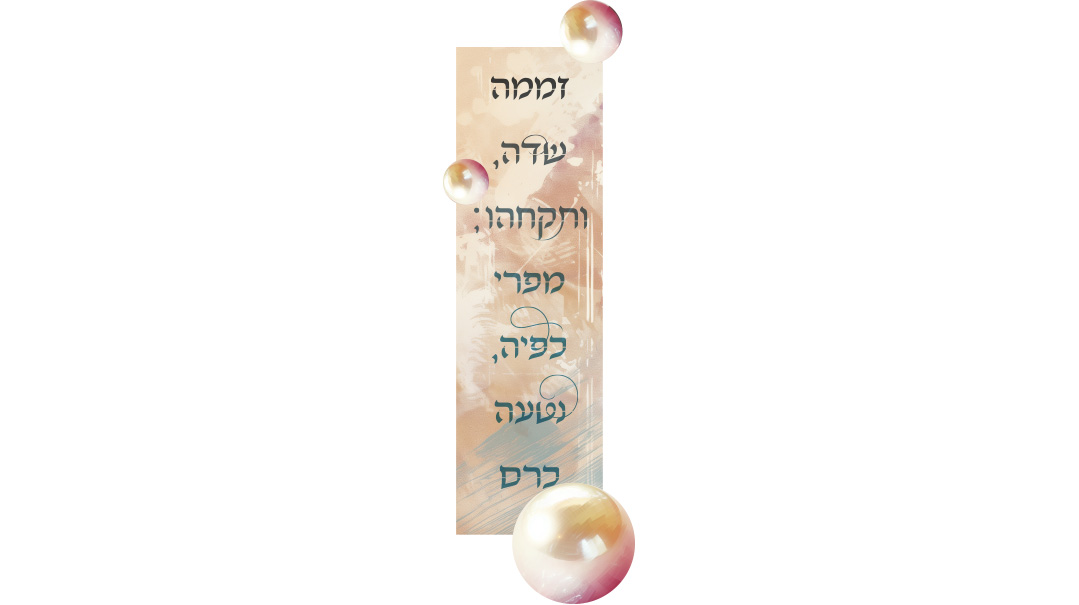Chana’s Prayer
| May 20, 2025Shlomo Hamelech gives us a taste of what life is really about

טָעֲמָה כִּי טוֹב סַחְרָהּ
לֹא יִכְבֶּה בַלַּיְלָה נֵרָהּ
Chana’s Prayer
Rebbetzin Shira Smiles
H
ere we have a reference to Chana the prophetess, with her unique insight into the power and value of tefillah.
“Kirvas Elokim li tov,”(Tehillim 73:28) says Dovid Hamelech, characterizing the ultimate goodness as closeness to Hashem, which can be achieved with attention to our tefillah.
As we see with Chana, Hashem orchestrates our circumstances to generate specific needs, which in turn elicits heartfelt tefillos to inspire this closeness. The goal of tefillah, then, is not as much to get what we desire, but to achieve connection with Hashem.
Chazal derive a number of halachos of tefillah from the manner in which Chana davened. “V’Chana hi medaberes al libah — but Chana, she was speaking in her heart” (Shmuel I 1:13). From here we learn that one must focus one’s heart during tefillah. “Rak s’fasehah na’os — only her lips were moving” teaches us to enunciate the words we say. “V’kolah lo yishamei’a — and her voice was not heard” — tells us that when davening Shemoneh Esreh, we shouldn’t raise our voice.
Rav Bar Shaul, in Mitzvah V’lev, explains that speech is a unique feature of the medaber, the human being. “Kol,” simply making a sound, isn’t unique to humans, it’s universal to the animal kingdom. When communicating with Hashem, the voice acts as a barrier; it’s as if the voice is being heard, not the true essence of the person.
Chana also models how to employ tefillah as a medium of hoda’ah, thanking Hashem. She sings shirah, not only thanking Hashem for the birth of her son, but addressing Hashem’s mastery over the whole world. She mentions Hashem’s name nine times in this shirah, corresponding to the nine brachos in the Mussaf tefillah on Rosh Hashanah. How appropriate that we read Chana’s story as the haftarah on Rosh Hashanah!
The Midrash ascribes the end of the verse in Eishes Chayil, “lo yichbeh ba’laylah neirah — her lamp does not go out at night” to Chana’s son Shmuel, who parallels Moshe Rabbeinu and Aharon HaKohein. Shmuel Hanavi’s light, his prophecy, links the period of the Shoftim to the period of the Melachim. Rooted in a mother who understood how to daven and connect to Hashem, is a son whose whole life was dedicated to bringing Am Yisrael close to Hashem.
Chazal teach that ten measures of speech descended to the world, with women receiving nine of them. In his work Nefesh Chaya, Rav Pincus ztz”l quotes the idea that the word “sichah,” which is used by Chazal to indicate speech, also expresses prayer. Women can daven all day, both formally from the text of the siddur, as well as in organic conversation with Hashem. Let’s take inspiration from noble Chana to look at our own circumstances and situations as opportunities to connect in a heartfelt, intimate manner.
Rebbetzin Shira Smiles is a lecturer in the Yerushalayim area, and a mechaneches in Darchei Binah Seminary. She is the author of Torah Tapestries, which includes extensive essays on each parshah, and Arise and Aspire, on birchos hashachar.
The Best Merchandise
Rebbetzin Debbie Greenblatt
T
orah is d’beste s’choirah — Torah is the best merchandise — is a refrain many of us heard while growing up. It was for the sake of the Jewish people’s connection to Torah that the world was created. It’s our connection to Torah that informs the trajectory of history and it’s through Torah that the world will be perfected.
It’s not difficult to relate to these grand ideas on a macro level. It gets thornier on the micro level. Many things get in the way of these ideas having true expression in our lives. Sometimes it’s the busyness of life. The task of the yetzer hara is to prevent us from having the headspace to think about what the alignment of our beliefs and our lives actually look like.
As women, we’re more naturally attuned to the Will of Hashem, as we say in the morning blessing, that “He created me according to His Will.” Yet this isn’t enough. If we simply rely on the Jewish knowledge we absorbed in our youth, or the Torah we learned on our journey toward observance, we often aren’t equipped to deal with life’s challenges. It’s not the knowledge itself, but our connection to it that nurtures us. If we don’t make an effort to replenish our connection to Torah, we start to run out of gas.
The Eishes Chayil has tasted — ta’amah — this connection firsthand, and she knows it’s good.
We need to reinvigorate our connection to Torah through Torah learning itself, and to counter our immersion in general knowledge not just with more Torah information, but with a connection to deeper Torah wisdom that address the whys of life, touches our hearts, gives purpose to our days and inevitable nights, and provides the impetus to go forward even in the greatest times of challenge.
Find a study partner, listen to — or better yet, go to — a shiur that gives you a taste of that deeper Torah wisdom. Once you taste it, it will draw you back for more, because as King David said, “Ta’amu ure’u ki tov Hashem.”
Rebbetzin Debbie Greenblatt is a senior lecturer for the Gateways organization and a teacher of both the observant and the not-yet-observant. She is also director of education at Core.
Positive Spin
Mrs. Shira Hochheimer
I
’m up to an emptier nest phase. I was bemoaning my quiet house to my sister. “It’s just us and my daughter for Shabbos.” Her response changed my attitude. “Just?” she replied. “You’re the Thriving Three! You’ve been waiting twenty years to be able to spend time with the person you married and now you can! That’s not just anything.”
Her reframing put a new spin on this stage that others speak about so mournfully. And we have been thriving, taking walks and playing board games.
When Yaakov and Eisav meet in parshas Vayishlach, it was the clash of two worlds. Yaakov tells Eisav, “Yesh li kol — I have everything.” I have what I need and I need what I have. Yaakov was whole.
Eisav, in contrast, replies to Yaakov, “Yesh li rav — I have a lot.” He could always use more. He has a Lexus, but now he wants a Cybertruck.
These two perspectives battle within a person every day. For any situation, there’s one voice in our head saying, “Yesh li kol — life is perfect. My ancestors could only dream of the brachos I have every day.” Then there’s the other voice that says, “My husband is too messy, I have no friends, and I need to lose ten pounds.”
The Eishes Chayil teaches how to change our view to be more like Yaakov’s. She discerns that her merchandise, what she has, is good.
Taam also means to taste. Our thoughts, like our taste buds, can be shaped. When I stop eating sugar or Splenda, fruit suddenly tastes much sweeter. Likewise, during my life, I can choose what my experiences taste like based on how I choose to perceive them.
The Ralbag explains that the Eishes Chayil has the wisdom to view the results of her actions and recognize that what she is doing has value. The end of the pasuk tells us why this attitude is so important. Lo yichbeh ba’laylah neirah — her candle doesn’t go out at night. There are times in life that are uncontrollably hard and dark. When you know that what you’re doing has value, you can get through the rough patches without burning out. Furthermore, seeing the good is what gives us the mental and emotional capacity to handle everything in life with strength, if not with joy.
What is something in your life you can reframe to see the positive in it?
Mrs. Shira Hochheimer is the author of Eishes Chayil: Ancient Wisdom for Women of Today, a presenter for Torat Imecha Nach Yomi, and an administrator for WITS in Baltimore, MD.
(Originally featured in Family First, Issue 944)
Oops! We could not locate your form.







